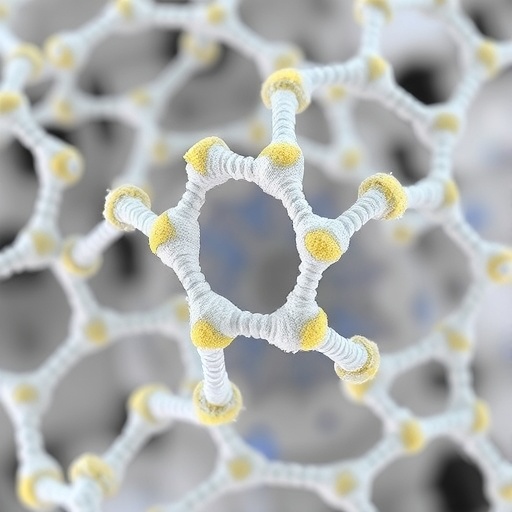Scientists are continuously exploring innovative methods to enhance bone tissue engineering, crucial for treating various skeletal injuries and disorders. A breakthrough study led by researchers Yu, G., Sun, X., and Geng, Z. has introduced a novel approach focusing on the use of nanocomposite scaffolds infused with Camellia Sinensis extract, commonly known as green tea, along with bone marrow mesenchymal stromal cells (BMSCs). This research, set to be highlighted in the Journal of Medical and Biological Engineering, aims to revolutionize the way bone regeneration is approached in clinical settings.
Bone tissue engineering is an interdisciplinary field that combines principles from biomaterials, cellular biology, and engineering to create structures that can support the development and regeneration of bone tissue. The challenge arises from the need for effective scaffolds that provide adequate support and promote cell attachment, proliferation, and differentiation. Traditional scaffolding materials often fall short when it comes to mimicking the complex microenvironment of natural bone. In response to these challenges, the team developed nanocomposite scaffolds that promise to pave the way for more effective bone repair strategies.
The incorporation of Camellia Sinensis extract into the scaffolds is a pivotal aspect of this study. Green tea extract is widely recognized for its antioxidant properties and its potential to promote cell proliferation while inhibiting apoptosis. By loading the scaffolds with this extract, the researchers hypothesize that they can enhance the biological activity of the scaffolds, improving outcomes in bone healing. This natural bioactive compound may not only support the viability of BMSCs but also promote the production of extracellular matrix components critical for successful bone formation.
In the study, the nanocomposite scaffolds will undergo rigorous characterization to assess their mechanical, structural, and biological properties. Mechanical strength is particularly crucial, as the scaffolds must support the physiological loads that bones typically endure. A combination of techniques, including scanning electron microscopy (SEM) and mechanical testing, will be employed to evaluate the scaffolds’ porosity, surface morphology, and tensile strength.
The biological evaluation will focus on the interaction between the loaded BMSCs and the scaffold material. The research team will assess cell attachment and proliferation rates to determine the compatibility of these nanocomposite structures with bone marrow-derived cells. The presence of growth factors and signaling molecules within the scaffolds, potentially influenced by the green tea extract, will also be analyzed to gain insights into the mechanisms underlying enhanced cell behavior.
One innovative aspect of this work is the examination of the bioactivity of the scaffolds in vivo. Animal models will provide invaluable data regarding the scaffolds’ efficacy in promoting bone regeneration in a live organism. This research aims to closely observe critical parameters, including new bone formation, scaffold degradation rates, and overall healing outcomes. These findings are expected to provide empirical evidence supporting the use of nanocomposite scaffolds in clinical applications.
Another exciting aspect of this research is the potential for scalability in clinical practice. The ability to fabricate these nanocomposite scaffolds using simple, reproducible methods could lead to widespread adoption in medical facilities. Moreover, the possibility of incorporating additional bioactive agents or optimizing the concentration of Camellia Sinensis extract further broadens the scope of this technology, making it adaptable for various clinical needs.
Critical insights from this study could lead to significant advancements in strategies for treating conditions such as osteoporosis, fractures, and even complex bone defects resulting from trauma or surgical interventions. By combining biological materials and innovative engineering techniques, the team is setting a precedent for future research in regenerative medicine. This approach has the potential to fill critical gaps in our current understanding and practice of bone repair.
The researchers are optimistic about their findings, believing that the promise shown by these nanocomposite scaffolds could lead to improved healing processes, shorter recovery times, and better long-term outcomes for patients needing bone regeneration. As they prepare for publication and subsequent peer review, the anticipation surrounding the potential impact of this research is palpable, both within the academic community and beyond.
In conclusion, as the field of bone tissue engineering continues to evolve, studies like this one are essential. They embody the integration of natural extracts with cutting-edge engineering, potentially overcoming barriers that have persisted in traditional approaches to bone repair. By merging techniques from diverse scientific domains, such approaches may lead to a new dawn in regenerative medicine, changing how we view healing and supporting our bodies’ natural recovery processes.
This groundbreaking study not only opens new doors in bone tissue engineering but also encourages researchers worldwide to explore biocompatible materials and bioactive compounds. As more investigations are conducted, the hope is to establish more effective treatment paradigms for those afflicted by debilitating skeletal disorders, ultimately improving patient quality of life through innovative medical solutions.
Overall, this research exemplifies the importance of collaborative scientific endeavors and how they can lead to solutions that provide better therapeutic options for clinical applications in bone repair and regeneration. As methodologies improve and our understanding deepens, it is exciting to envision the future of skeletal health and the transformative potential held within the fusion of biology and technology.
Subject of Research: Bone Tissue Engineering via Nanocomposite Scaffolds
Article Title: Bone Tissue Engineering via Nanocomposite Scaffolds Loaded with Camellia Sinensis Extract and Bone Marrow Mesenchymal Stromal Cells
Article References:
Yu, G., Sun, X. & Geng, Z. Bone Tissue Engineering via Nanocomposite Scaffolds Loaded with Camellia Sinensis Extract and Bone Marrow Mesenchymal Stromal Cells.
J. Med. Biol. Eng. 45, 127–137 (2025). https://doi.org/10.1007/s40846-025-00931-w
Image Credits: AI Generated
DOI: https://doi.org/10.1007/s40846-025-00931-w
Keywords: Bone Tissue Engineering, Nanocomposite Scaffolds, Camellia Sinensis Extract, Bone Marrow Mesenchymal Stromal Cells, Regenerative Medicine.




